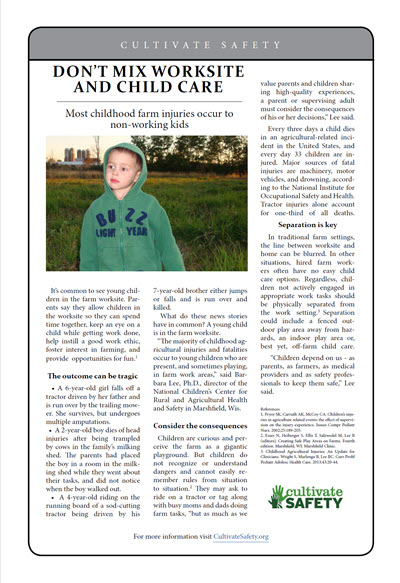Play
Each year, more than 100 children are killed and nearly 12,000 are seriously injured on U.S. farms. The highest rate of injuries involves children younger than 10 years old who were playing in the worksite. To prevent these injuries, create, use, and maintain a safe play area on your farm. More information is available below.

Non-Working
Learn the main causes of injury to non-working youth on farms and what you can do.
Learn More

Safe Play
An ideal play area blends activities matched to the developmental stages and abilities of children.
Learn More

Agritourism
Agritourism website which provides tools and resources to help farm owners keep visitors safe.
Visit Site
Leading Causes of Injury to Non-Working Children on Farms
Deaths
- Runover as bystander
- Runover as passenger
- Drowning
Hospitalized Injury
- Fall from heights
- Machinery entanglement
- Animal (falls, struck by, crushed by)
Medically Treated Injury
- Animal (falls, struck by, crushed by)
- Falls from heights
Preventing Injuries to Non-Working Children
Prohibit access to the farm worksite
- Arrange off-farm childcare
- Build a safe play area
Keep kids away from tractors
- Keep kids away from tractors (Poster)
- Keep kids away from tractors (Video)
- Keep kids away from tractors (Prevention Brief)
Install passive physical barriers
- Fence water hazards
- Install fall protection in haylofts
- Fence animal enclosures
- Install barriers around machinery and vehicle compounds
- Build a safe play area
Institute safe storage practices
- Don’t lean large objects (tires, water troughs, etc) against walls
- Put away tools and sharps
Identify child care alternatives
- Arrange off-farm childcare
- Arrange in-home childcare
Develop and enforce consistent rules for recreational activities
- ATV Information
- Horses and riding activities
Safe Play
Playing is an important means for children to develop physically, emotionally, socially, and intellectually. Different types of play activities influence these attributes of development. An ideal play area blends activities matched to the developmental stages and abilities of children. Click the thumbnails below to learn more.














